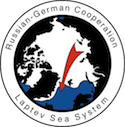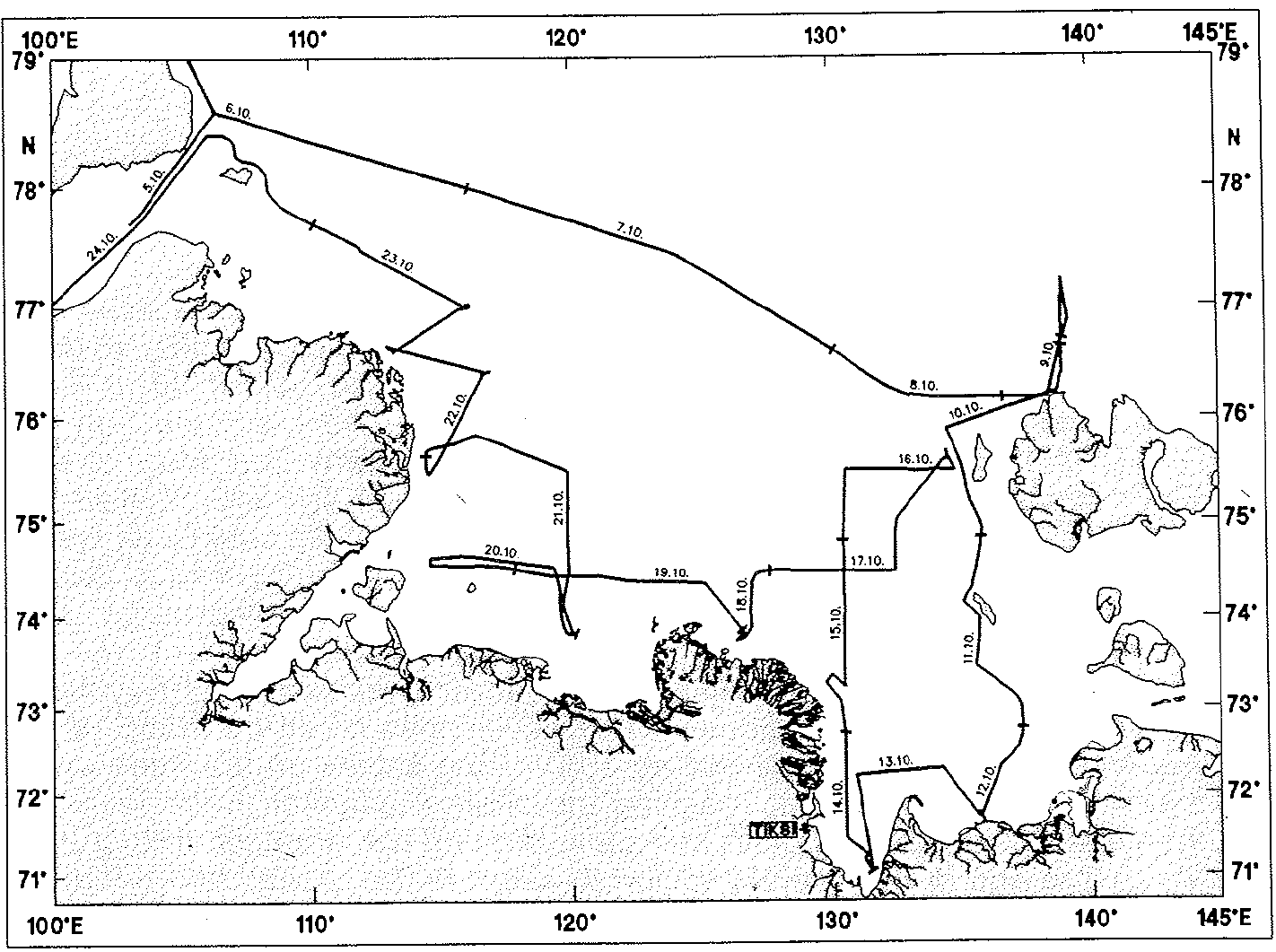 TRANSDRIFT III
TRANSDRIFT III
On October 1, 1995, the TRANSDRIFT III expedition sailed from Murmansk, headed for the Laptev Sea onboard the Russian icebreaker Kapitan Dranitsyn. The research team consisted of 52 scientists, whose main working areas were the coastal regions of the eastern Laptev Sea, e.g., the Lena Delta and the region of the Laptev Sea polynya. The expedition returned to Murmansk on October 30, after having carried out 75 ship and 64 helicopter stations in the Laptev Sea during the period of October 6 to 24, 1995.
The research program focused on the fall freeze-up. It was the first study of its kind under these conditions. Sea-ice formation processes were studied considering the effects on biological productivity, entrainment of particulate and dissolved matter, and hydrodynamic processes. Meteorological boundary conditions and the influence of river outflow were continously recorded. Multidisciplinary experiments included:
- ice observations by remote sensing techniques and continuous ship and helicopter-based ice monitoring
- measurements of physical and chemical properties of the water column, and of its suspension and ice load by CTD, current meters, underwater photography, and water sampling
- observations of the ice structure by drilling and subsequent investigation of various physical, chemical, and biological characteristics
- bio-ecological studies including the biota's reaction on new-ice formation and ice coverage
- sedimentological investigations of the seafloor deposits, suspended particulate matter and sea-ice sediments
Freeze-up began one month later than usual (a 40-year record) close to the Novosibirskie Islands in low salinity surface waters due to heat stored in an intermediate water layer between 10 and
25 m water depth. Later, huge tracts of turbid, dirty ice were found off the Lena Delta where an unusually high phytoplankton concentration for this time of year occurred. The origin of these anomalies, if that is what they are, and their relationship to global environment will be the focus of the ongoing research.
Here you can download the cruise report.
The weekly reports of the expedition can be found here.
The participants of the expedition:
Chief scientists
- Igor Dmitrenko, Arctic and Antarctic Research Institute
- Heidemarie Kassens, GEOMAR Research Center for Marine Geosciences
Coordinators
- Joern Thiede, GEOMAR Research Center for Marine Geosciences
- Leonid Timokhov, Arctic and Antarctic Research Institute
Paleoceanography
- Martin Antonow, Technical University Bergakademie Freiberg
- Albert Benthien, GEOMAR Research Center for Marine Geosciences
- Holger Cremer, GEOMAR Research Center for Marine Geosciences
- Bernhard Fuerst, Technical University Bergakademie Freiberg
- Veit Haase, GEOMAR Research Center for Marine Geosciences
- Heidemarie Kassens, GEOMAR Research Center for Marine Geosciences
- Vera Kosheleva, All-Russia Research Institute of Geology and Mineral Resources of the World Ocean (VNIIOkeangeologia)
- Martina Kunz-Pirrung, GEOMAR Research Center for Marine Geosciences
- Constanze Langner, Alfred Wegener Institute for Polar and Marine Research
- Evgeniy Musatov, All-Russia Research Institute of Geology and Mineral Resources of the World Ocean (VNIIOkeangeologia)
- Dirk Nuernberg, GEOMAR Research Center for Marine Geosciences
- Bernhard Peregovich, GEOMAR Research Center for Marine Geosciences
- Martina Siebold, Alfred Wegener Institute for Polar and Marine Research
- Joern Thiede, GEOMAR Research Center for Marine Geosciences
- Rasmus Thiede, Technical University Bergakademie Freiberg
Sea-ice studies
- Vitaliy Alexandrov, Arctic and Antarctic Research Institute
- Andrey Darovskikh, Arctic and Antarctic Research Institute
- Valero Delgado, Alfred Wegener Institute for Polar and Marine Research
- Johannes Freitag, Alfred Wegener Institute for Polar and Marine Research
- Josef Kolatschek, Alfred Wegener Institute for Polar and Marine Research
- Sergey Kovalev, Arctic and Antarctic Research Institute
- Frank Lindemann, GEOMAR Research Center for Marine Geosciences
- Erk Reimnitz, US Geological Survey
- Mikhail Strakhov, Arctic and Antarctic Research Institute
- Konstantin Tyshko, Arctic and Antarctic Research Institute
Oceanography
- Igor Dmitrenko, Arctic and Antarctic Research Institute
- Nikolay Dmitriev, Arctic and Antarctic Research Institute
- Pavel Golovin, Arctic and Antarctic Research Institute
- Alexandr Ipatov, Arctic and Antarctic Research Institute
- Leonid Timokhov, Arctic and Antarctic Research Institute
Geochemistry
- Jens Hoelemann, GEOMAR Research Center for Marine Geosciences
Marine chemistry
- Sergey Pivovarov, Arctic and Antarctic Research Institute
- Bettina Rossak, GEOMAR Research Center for Marine Geosciences
- Martina Schirmacher, GKSS Research Center Geesthacht GmbH
- Stefanie Schultz, Institute for Marine Science
- Yury Sherbakov, Arctic and Antarctic Research Institute
- Christopher Strobl, Heidelberg Academy of Sciences
- Viktor Sviridov, Arctic and Antarctic Research Institute
- Evgeniy Zakharchuk, Arctic and Antarctic Research Institute
Meteorology
- Alexandr Korablev, Arctic and Antarctic Research Institute
- Andrey Zachek, Arctic and Antarctic Research Institute
Biology
- Viktor Petryashov, Zoological Institute of the Russian Academy of Sciences
- Dieter Piepenburg, Institute for Polar Ecology
- Michael Schmid, Institute for Polar Ecology
- Kirsten Tuschling, Institute for Polar Ecology
- Karen von Juterzenka, Institute for Polar Ecology
Hydrooptics
- Andrey Anoshkin, Krylov Shipbuilding Research Institute
Technician
- Sergej Neufeld, GEOMAR Technology GmbH
Interpreter
- Bettina Rohr, GEOMAR Research Center for Marine Geosciences
Journalist
- Andreas Berger, Norddeutscher Rundfunk
- Karl-Heinz Burmeister, Norddeutscher Rundfunk
- Juergen G. Kirndoerfer, Norddeutscher Rundfunk



